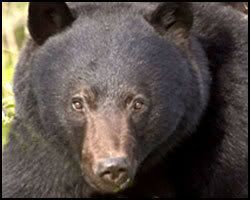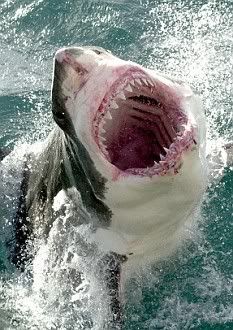
Today I thought I conclude this animal attack series with a few more accounts on cougar and bear incidents.
Of course, this week would not be complete without also including a few shark attack stories and other meanderings.
Urban Wildlife: Cougars
Here in California, urban wildlife (coyotes, bobcats, cougars) often prey on pets. At least this is the case in some of the areas I’ve lived.
Last week a dog (Buddy) was taken by a cougar from the yard in La Canada/Flintridge, California and the other, missing for six weeks, is feared to have met the same death. The owners recount the story in the news article. Heartbreaking.
Cougars are predators and so it isn’t a surprise to find them preying on pets. However, like coyotes who have been known to ignore pet owners and grab a pet for a meal, urban mountain lions seem to be getting more daring.
As I mentioned previously, humans unwittingly tend to provide snacks and water to attract animals which attracts the predators that prey on them.
Urban Wildlife: Bears
In the case of bears, garbage attracts them and they get territorial over the area providing the source of food–making them a danger.
It also creates a humans=food association which is never a good thing.
Dogs were also the victims of a black bear near Santa Barbara, California. Dry weather and the recent fires  have driven wildlife into smaller areas and removed vast areas of natural resources and territories.
have driven wildlife into smaller areas and removed vast areas of natural resources and territories.
Then there is the disturbing trend of predatory attacks by black bears. Up in Canada, another aggressive black bear was shot and killed in the same neighborhood of Coquitlam, B.C. where a woman was attacked outside her home earlier this week.
Herrero, bear attack expert and author of Bear Attacks: Their Causes and Avoidance (revised) estimated that on average, bears kill three people and seriously injure between five and 15 annually in North America. He was quoted as stating, “Overall the injury rates are very low considering the millions of interactions that occur each year,”
In the revised edition of Bear Attacks (first published in the mid-1980s) the causes and avoidance of attacks by brown (the grizzly is a brown bear) and black bears are examined based on scientific analysis of 414 detailed records of encounters between bears and people. Details and analysis of certain attacks and non-injurious interactions are included in this work.
In 2000, Herrero was interviewed by the Calgary Herald who reported that the number of bear attacks that year was among the highest since biologists began keeping records 28 years ago even though specific numbers were unavailable.
The rule of thumb has always been to play dead in grizzly bear incidents and to fight back in black bear incidents but there are always exceptions to the rule. I’ve blogged about prevention before and carrying and using bear deterrent may help you if faced with a cougar or bear encounter.
Cougars are stealthy but any tool is a good one.
BTW: Yellowstone’s bear man has some interesting notes and so does Herrero’s Eastern Slopes Grizzly Bear Project. I also liked the Massachusetts Department of Fish & Wildlife Black Bear Problems & Control page.
Shark Attacks & Other Musings
The Discovery Channel’s Shark Week just recently concluded. I love the series because it takes a look into all  types of shark behavior, research, biology, and human encounters.
types of shark behavior, research, biology, and human encounters.
In my career span I’ve worked with a variety of animals and only two make me nervous in the wild.
Great White Sharks is one species on this list just because when I was a surfer I enjoyed night rides and was active at dawn and dust in areas where white sharks were known to frequent–it is a always a risk.
Scientists have come up with a bite measurement for the great white shark–1.8 tons of bone crunching force.
Yikes!
The measurement came from Sydney, Australia and you can read more about the finite element analysis here.
Not too long ago in Makaha, Hawaii a snorkeler was attacked by a shark. The Early Show also has a video up of their interviews with shark attack survivors.
If you are interesting in shark attacks you can get useful information from the International Shark Attack Files from the Florida Museum of Natural History.
Shark repellents, barriers (chain mail, cages) are some of the products you may have heard about but a new shark attack risk reduction product is on the market.
Shark Shield was developed in Australia, where they have a lot of problems with sharks.
The device can be mounted on the back of a surfboard or a kayak, or a lightweight neoprene model can be strapped to the calf of a diver. Cost range? $680 to $800.
The Shark Shield includes a rechargeable battery in a waterproof pack, transmitter, and rubber-coated antenna.
However, using these common sense tips to reduce your risk of shark attack is something you can do while you save money to buy the new device.
I hope you have enjoyed this week’s focus on animal attacks. Let me know your thoughts about it below.


I think the reason there’s an increase in cougar and bear attacks is because humans are encroaching on their territory.
While pet owners may be heartbroken, they need to understand the mountain lions and bears were here long before we were and we need to take precautions not to tempt them with garbage or pets out alone early in the morning or late in the evening.
Especially with fall upon us, bears will be storing up fat for the long winter, so will be looking wherever they can. Don’t feed the foxes or the squirrels. Let them forage for themselves. In the long run we’ll probably have a lot less aggressive encounters.
Dagny
Dagny, thanks for stopping in. I mentioned most of the things you highlight in my animal attack series this week. Human stupidity is something I’ll never understand. Many of my neighbors complain but won’t take steps to alleviate the situation…like waiting to put their trash out the morning of pick-up instead of the night before.
If you haven’t checked out the air jaws videos that the discovery channel has done I highly recommend them. They have some amazing footage and I think Planet Earth has also done some slow mo videos that are incredible.